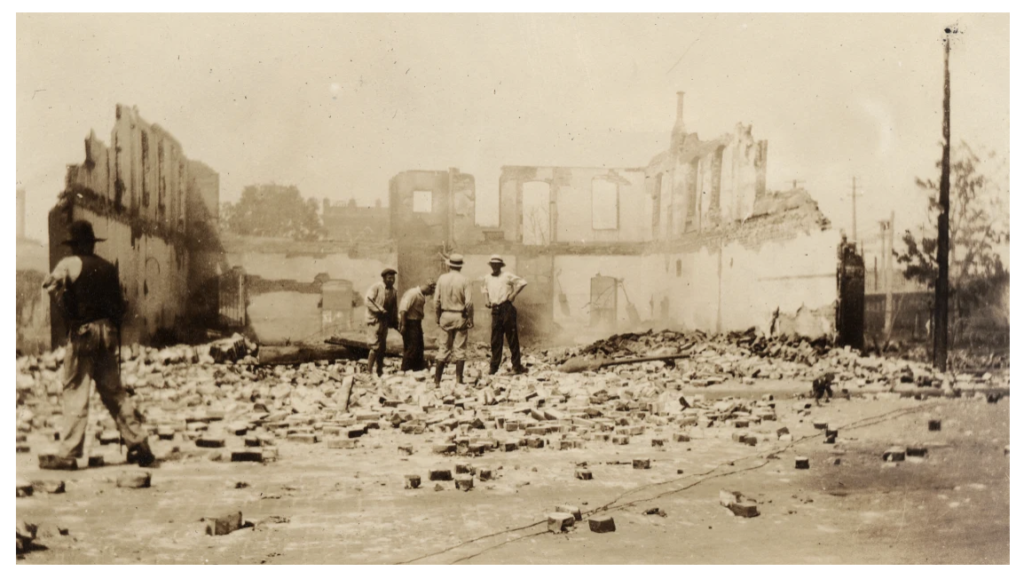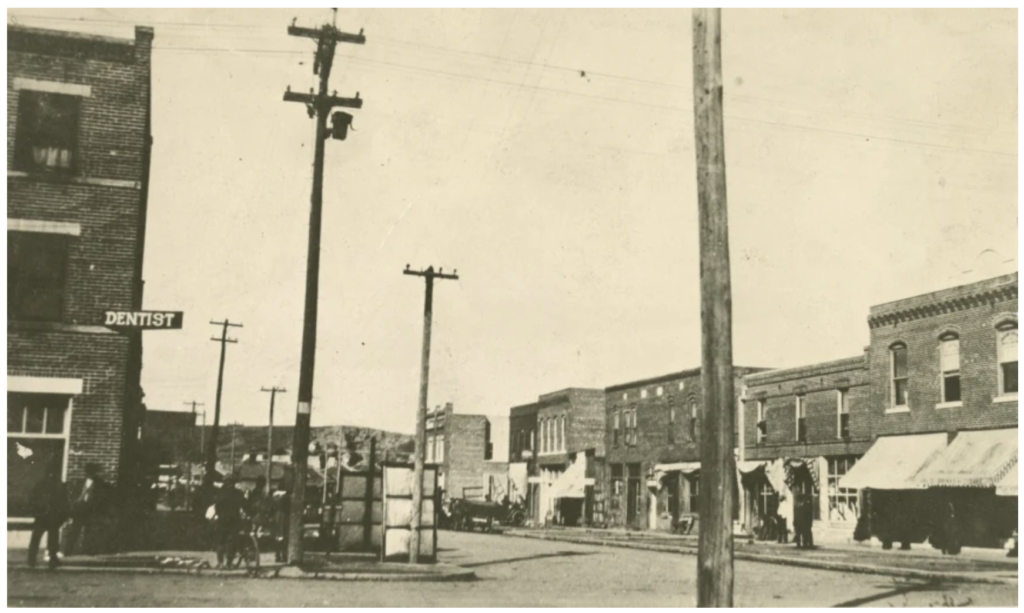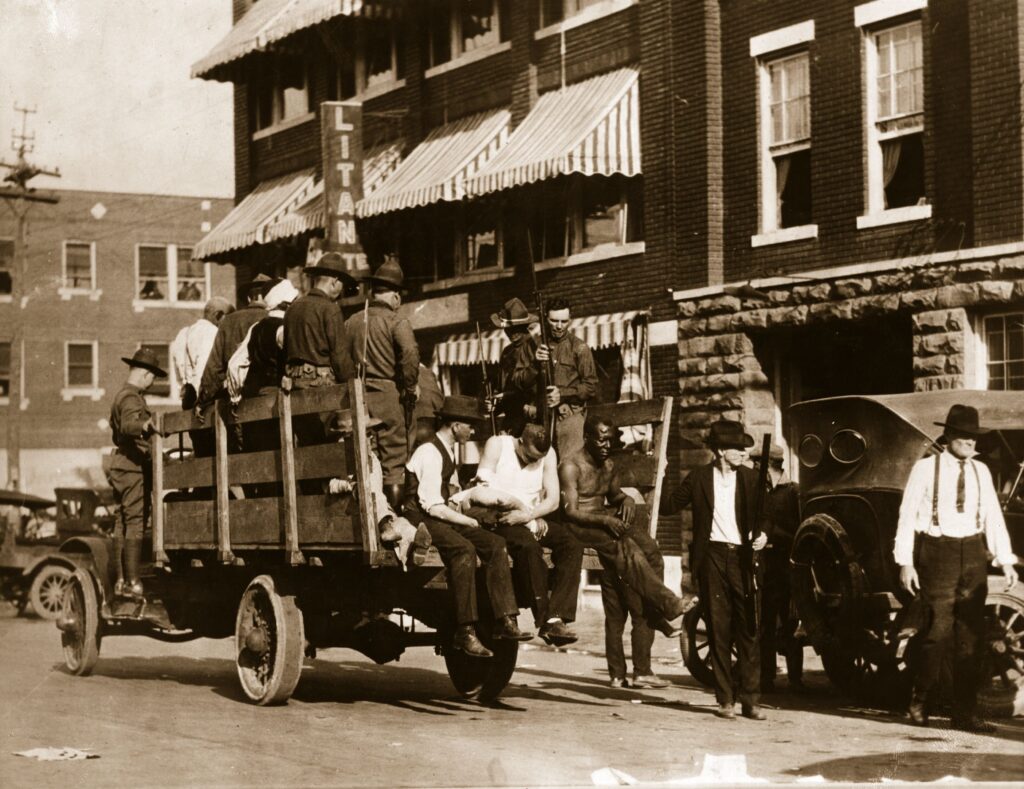Why it happened and why it’s still relevant today
The city’s “Black Wall Street” was among the most prosperous neighborhoods in America, and a Black utopia — and then it was burned to the ground.
Just decades after slavery in the United States left Black Americans in an economic and societal deficit, one bright spot stood out in Tulsa, Oklahoma — its Greenwood District, known as the “Black Wall Street,” where Black business leaders, homeowners, and civic leaders thrived.
But 100 years ago, on May 31, 1921, and into the next day, a white mob destroyed that district, in what experts call the single-most horrific incident of racial terrorism since slavery.
An estimated 300 people were killed within the district’s 35 square blocks, burning to the ground more than 1,200 homes, at least 60 businesses, dozens of churches, a school, a hospital and a public library, according to a report issued by Human Rights Watch.

At least $1.4 million in damages were claimed after the massacre, or about $25 million in today’s dollars, after controlling for inflation and the current economy, but experts say it’s an underestimation.
Survivors never received government assistance or restitution for their losses. The House Judiciary Subcommittee on the Constitution, Civil Rights, and Civil Liberties held a hearing on the issue May 19 in which three remaining known survivors, experts and advocates called on Congress to issue reparations to the living survivors and all descendants to rectify the lasting impact of the massacre.
“I had everything a child could need,” Viola Ford Fletcher, 107, told the committee. “The night of the massacre, I was awakened by my family. My parents and five siblings were there. I was told we had to leave and that was it. I will never forget the violence of the hate mob when we left our home. I still see Black men being shot, Black bodies lying in the street. I still smell smoke and see fog. I still see Black businesses being burned. I still hear airplanes flying overhead. I hear the screams. I live through the massacre every day. Our country may forget this history, but I cannot.”
How ‘Black Wall Street’ began
O.W. Gurley, a wealthy Black landowner, purchased 40 acres of land in Tulsa in 1906 and named the area Greenwood. Its population stemmed largely from formerly enslaved Black people and sharecroppers who relocated to the area fleeing the racial terror they experienced in other areas.
But Oklahoma, which became a state in 1907, was still staunchly segregated at the time. So as Gurley opened a boarding house, grocery stores and sold land to other Black people, they secured their own houses and opened businesses. The population grew to 11,000 and the area became an economic powerhouse affectionately called “Black Wall Street.”
Greenwood functioned independently, with its own school system, post office, bank, library, hospital and public transit. It also had luxury shops, restaurants, grocery stores, hotels, jewelry and clothing stores, movie theaters, barbershops and salons, pool halls, nightclubs and offices for doctors, lawyers and dentists.

Hannibal Johnson, author of “Black Wall Street: From Riot to Renaissance in Tulsa’s Historic Greenwood District,” said the area thrived as an ancillary economy that kept money within the community. Even those who worked outside of Greenwood only spent their money in the area, reinvesting in the neighborhood, he said.
“The district really took off as an economic and entrepreneurial kind of Mecca for Black folks because this was an era of segregation,” he said. “Black folks were shut out from the dominant white-led economy in what I call an economic detour. In other words, when they approached the gate of economic opportunity at the white dominated downtown Tulsa economy, they were turned away. So they created their own insular economy in the Greenwood district and blossomed because dollars were able to circulate and recirculate within the confines of the community because there really was not much of an option, given the segregation that existed here and elsewhere.”
This prosperity continued through the years even as racial terrorism around Tulsa grew, the Ku Klux Klan gained power, and Oklahoma’s Supreme Court regularly upheld voting restrictions such as poll taxes and literacy tests for Black voters. By 1919, white civic leaders sought Greenwood’s land for a railroad depot or other uses.
“You have a really successful Black business community across the Frisco tracks, literally across the tracks from downtown Tulsa,” said Johnson, the education chair for the Centennial Commission. “You have white people, some of whom are not doing well economically, who can look across those tracks and see Black people living in homes, driving cars, furnishing their homes with pianos, women wearing furs, all the trappings of economic success. And so there’s that dissonance between what these people think ought to be, based on white supremacy, and what actually is. And one of the ways to harmonize that dissonance is to bring the Black folks down a peg through violence.”
What ignited the massacre
Tulsa police officers arrested Dick Rowland, a Black 19-year-old, May 31, 1921 for allegedly assaulting a white girl, the report said, but there was little evidential proof. The Tulsa newspapers swiftly published incendiary articles about the allegation, prompting a group of mostly white men to descend on the courthouse to lynch Rowland.
When Greenwood residents learned of the impending lynch mob, a group of mostly Black men, which included World War I veterans, armed themselves and went to the courthouse to protect Rowland. This method became custom whenever Black people were on trial as they usually faced lynchings.
But the sheriff told the group to leave and they complied. The white mob grew to more than 2,000 and Tulsa police did not disperse the crowd. Later that night, the armed Black men returned to protect Rowland and a fight broke out when a white man tried to disarm a Black man, prompting shooting that lasted through the night, the report said.
In the early hours of June 1, 1921, then-Gov. James B. A. Robertson dispatched the National Guard and declared martial law. The National Guard, local law enforcement, and deputized white citizens canvassed Greenwood to disarm, arrest and move Black people to nearby internment camps, dragging some out of their homes. This upheaval resulted in the uncontested mob outnumbering the remaining Black people by 20 to 1, the report said. Old World War I airplanes dropped bombs on Greenwood, with the mob fatally shooting Black people and looting and burning their homes and businesses.
Dreisen Heath, a researcher at Human Rights Watch who authored the report, said law enforcement’s involvement in the massacre illustrates the demands of racial justice movements a century later.
“A number of the massacres that happen that are normally coined as a riot — Memphis, Chicago, those are all places where you also have documentation of police participation and being deputized,” she said.
No one in the white mob was prosecuted or otherwise punished for the massacre, the report said.

